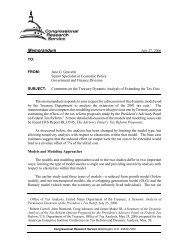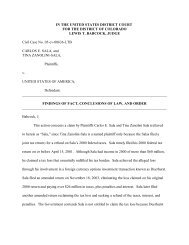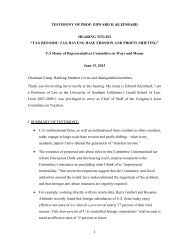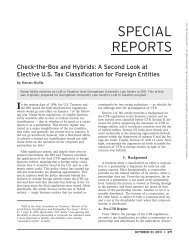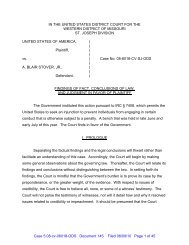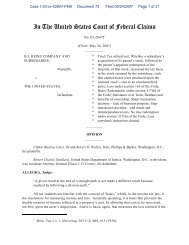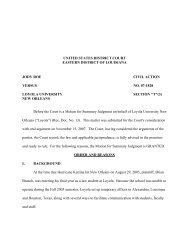Targeted Allocations Hit the Spot
Targeted Allocations Hit the Spot
Targeted Allocations Hit the Spot
Create successful ePaper yourself
Turn your PDF publications into a flip-book with our unique Google optimized e-Paper software.
COMMENTARY / SPECIAL REPORT<br />
C. Economic Certainty: Burden on Preparer<br />
Partnership agreements drafted using targeted<br />
allocations provide partners certainty as to economic<br />
results; <strong>the</strong>ir cash flow is not tied to <strong>the</strong><br />
vagaries of capital accounts. As is evident above,<br />
however, those agreements still require complicated<br />
and sophisticated drafting. The tax boilerplate that<br />
so many agreements lack is just as necessary for<br />
targeted tax allocation provisions as for traditional<br />
tax allocation provisions. Some of <strong>the</strong> recommendations<br />
in Part III designed to simplify tax allocation<br />
provision drafting are probably equally appropriate<br />
for targeted allocation agreements.<br />
<strong>Targeted</strong> allocation provisions are certainly more<br />
difficult for <strong>the</strong> tax return preparer than <strong>the</strong> traditional<br />
tax allocation provisions. <strong>Targeted</strong> allocation<br />
provisions skip <strong>the</strong> step-by-step detail on how to do<br />
<strong>the</strong> allocations. Even more important, <strong>the</strong> provisions<br />
force <strong>the</strong> tax return preparer to tackle capital<br />
accounts each year with rigor and accuracy. In<br />
many cases, this task is never encountered by tax<br />
return preparers for partnerships that contain traditional<br />
allocation provisions.<br />
This places tax return preparers in an unenviable<br />
position. At <strong>the</strong> same time, however, <strong>the</strong> partner has<br />
economic certainty in terms of <strong>the</strong> cash he would<br />
receive under various valuation scenarios.<br />
D. Tax Certainty (or Lack Thereof)<br />
1. <strong>Targeted</strong> allocations and economic effect tests.<br />
Partners in partnerships using targeted allocations<br />
are assured of receiving <strong>the</strong> distributions <strong>the</strong>y bargained<br />
for. Query whe<strong>the</strong>r <strong>the</strong> tax results are as<br />
certain.<br />
The issue is whe<strong>the</strong>r <strong>the</strong> partnership agreement<br />
satisfies <strong>the</strong> capital account liquidation requirement<br />
of <strong>the</strong> safe harbor economic effect and alternate<br />
economic effect tests. The capital account liquidation<br />
requirement under <strong>the</strong> regulations is that <strong>the</strong><br />
partnership agreement ‘‘provides’’ that ‘‘liquidating<br />
distributions are required in all cases to be made in<br />
accordance with positive capital account balances.’’<br />
32<br />
Those who do not believe in targeted allocations<br />
contend that even though per force <strong>the</strong> partnership’s<br />
liquidating distributions will be in accordance<br />
with capital accounts, <strong>the</strong> safe harbor<br />
economic effect tests are not satisfied because <strong>the</strong><br />
partnership does not explicitly provide for liquidations<br />
in accordance with capital accounts; it explicitly<br />
provides for liquidation based on distribution<br />
percentages. 33 This reading of <strong>the</strong> regulations may<br />
be too narrow.<br />
32 Reg. section 1.704-1(b)(2)(ii)(b)(2).<br />
33 Drafting treatise, supra note 27 at paras. 7-150.<br />
<strong>Targeted</strong> allocation provisions are designed to<br />
ensure that liquidating distributions will be made<br />
in accordance with capital accounts. A partnership<br />
agreement that contains those provisions can be<br />
said to ‘‘provide’’ that liquidating distributions are<br />
in accordance with capital accounts. The regulation<br />
does not require <strong>the</strong> partnership to ‘‘state’’ that<br />
liquidating distributions will be in accordance with<br />
capital account. 34 It uses <strong>the</strong> term ‘‘provides,’’ which<br />
has a broader meaning than <strong>the</strong> ‘‘explicitly states’’<br />
reading given by some. In this context, <strong>the</strong> term<br />
‘‘provides’’ has a result-oriented ra<strong>the</strong>r than meansoriented<br />
connotation. The ‘‘results’’ of targeted allocations<br />
satisfy this results-oriented test.<br />
Under <strong>the</strong> circumstances, properly drafted targeted<br />
allocation provisions that include a qualified<br />
income offset provision ought to satisfy <strong>the</strong> section<br />
704(b) alternate economic effect test. In view of<br />
several partnership agreements that rely on <strong>the</strong><br />
targeted allocation approach and <strong>the</strong> mixed views<br />
reflected in writings on this issue, it would be<br />
helpful for <strong>the</strong> IRS to issue a revenue ruling or<br />
notice blessing targeted allocations under <strong>the</strong> section<br />
704(b) alternate economic effect safe harbor.<br />
Recommendation 8: The IRS should issue a<br />
notice or revenue ruling indicating that targeted<br />
allocation provisions can qualify under<br />
<strong>the</strong> section 704(b) safe harbor economic effect<br />
and alternate economic effect tests. If desired,<br />
<strong>the</strong> IRS can specify appropriate conditions,<br />
subject to fur<strong>the</strong>r guidance in regulations.<br />
2. <strong>Targeted</strong> allocations and economic equivalence<br />
tests. If targeted allocations do not satisfy <strong>the</strong><br />
alternate economic effect safe harbor, query<br />
whe<strong>the</strong>r <strong>the</strong>y can satisfy <strong>the</strong> dumb-but-lucky economic<br />
equivalence safe harbor.<br />
As discussed earlier, this test validates allocations<br />
o<strong>the</strong>rwise flunking <strong>the</strong> economic effect test<br />
when <strong>the</strong> hypo<strong>the</strong>tical liquidation of <strong>the</strong> partnership<br />
would produce <strong>the</strong> same economic result for<br />
<strong>the</strong> partners in <strong>the</strong> current year or any future year as<br />
<strong>the</strong> economic effect test (maintain capital accounts,<br />
liquidate in accordance with capital accounts, unlimited<br />
deficit restriction) regardless of <strong>the</strong> economic<br />
performance of <strong>the</strong> partnership.<br />
As also discussed earlier, some distinguished<br />
commentators would limit this safe harbor to partnership<br />
agreements with unlimited deficit restoration<br />
provisions. This is too narrow a reading and<br />
does not well serve <strong>the</strong> interests of <strong>the</strong> IRS or<br />
34 Compare reg. section 1.704-2(e), which is <strong>the</strong> nonrecourse<br />
deduction safe harbor. This regulation says that <strong>the</strong> partnership<br />
agreement must ‘‘contain’’ a minimum gain chargeback provision.<br />
See also reg. section 1.704-1(b)(2)(ii)(d): ‘‘The partnership<br />
agreement contains a qualified income offset.’’<br />
(C) Tax Analysts 2010. All rights reserved. Tax Analysts does not claim copyright in any public domain or third party content.<br />
104 TAX NOTES, October 4, 2010







